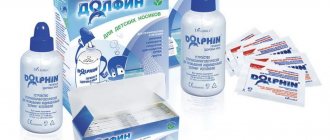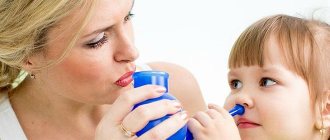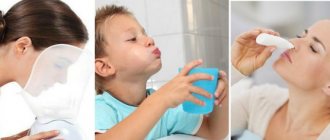With various ENT diseases, you often have to deal with the need to cleanse your nose. The most effective way is to wash it. Chlorhexidine will help in this difficult matter.
In this article we will look at what the drug is, what medicinal properties it has, whether it is possible to rinse the nose with Chlorhexidine for diseases such as sinusitis and rhinitis, and how to do it correctly.
Description of the drug
Chlorhexidine bigluconate is an aqueous antiseptic solution used to disinfect skin lesions and burns.
The effective effect of the drug on various viruses is a good recommendation for its use
in nasal rinsing during inflammatory processes.
The drug can destroy the film of bacteria and fungi that forms in the nasal cavity. This property helps other drugs act directly on the source of inflammation.
The medicine contains only two components: chlorhexidine bigluconate and water. Depending on the volume fraction of the active substance, the concentration of the drug and its area of application change.
Chlorhexidine: features of the product
The drug is classified as an antiseptic that can be used externally and locally. It has pronounced bactericidal, antimicrobial, antifungal and antiseptic properties. Timely and complete treatment with the drug allows you to get excellent results for many diseases.
Indications for use:
- for treating wounds, burns, cracks;
- for the treatment of fungal skin diseases;
- for the prevention of certain urological diseases;
- in the postoperative period to prevent the development of complications;
- for washing with viral inflammation of the maxillary sinuses.
Chlorhexidine is often used to treat wounds, and can be used for sinusitis to rinse the nose.
The drug is active against most gram-positive and gram-negative bacteria, it effectively affects various viruses that cause the development of sinusitis.
At the same time, we must not forget that Chlorhexidine is a potent medicine and should be taken with caution for sinusitis. It is important to ensure that the product does not accidentally get into the ear cavity or penetrate into the lining of the brain.
You cannot prescribe medications to yourself without an appropriate prescription from an otolaryngologist. Any careless actions can lead to even more serious consequences and complications.
Indications for use
This medicine has proven itself well for rinsing the nose with the following symptoms:
- runny nose;
- chronic rhinitis;
- purulent sinusitis.
Rinsing your nose is a common hygiene procedure, just like washing your face or brushing your teeth every day. Even a healthy person will benefit from periodically clearing his nasal passages.
Contraindications to rinsing, side effects
Specific contraindications and possible side effects include allergies. Treatment with Chlorhexidine and other rinsing drugs is not carried out in case of severe nasal congestion, since there is a risk of fluid and mucus entering the Eustachian tubes. Procedures are avoided when otitis develops, as they can aggravate the pathology.
Do not rinse if you are hypersensitive or prone to nosebleeds. An antiseptic solution can cause irritation and drying of the mucous membranes. Subsequently, microscopic cracks appear. Vascular permeability increases. The patient feels discomfort. Pathogens can enter open wounds. This increases the chance of bleeding and other complications.
Washing is not carried out in late stages of pathology and when conservative methods are ineffective. This is due to the inappropriateness of the procedure and the rapid spread of infection. In advanced cases, a puncture is prescribed to remove purulent contents and disinfect cavities.
After the procedure, discharge is observed for 30-60 minutes. This is a normal reaction, because some of the fluid remains in the nasal passages. Due to temporary breathing problems, a headache may persist for 20-30 minutes after rinsing.
Contraindications
Contraindications to the use of the product are:
- Children's age up to seven years. Children are not recommended to rinse their nose with Chlorhexidine. The fact is that young children have a very delicate and sensitive mucous membrane, which is responsible for the olfactory cells and protects the nasal cavity. The drug can easily damage it, even at low concentrations.
- The presence of mucosal edema. A blocked airway prevents nasal rinsing. Performing the procedure may cause the drug to enter the middle ear and contribute to the development of new inflammations. It is advisable to first remove the swelling with special means, and then carry out cleansing.
- High sensitivity. In some people, the mucous membrane of the nasal cavity is especially delicate. Under such circumstances, using the medicine is not recommended.
- Allergic reaction. Individual intolerance is a fairly common phenomenon. If a person has a tendency to develop allergies, then it is better not to risk it. Checking the body's reaction is very simple: just apply one drop of a weak solution of Chlorhexidine ( 0.02% ) to the mucous membrane and wait a couple of minutes. If severe burning occurs, it is better to avoid this medicine.
- Deviation of the nasal septum. It’s not even worth wasting energy on washing in such a situation. The action will still not bring the desired effect.
Hypersensitivity to Chlorhexidine
In some patients prone to allergic reactions, the antiseptic may cause allergies. Among the registered side effects we note:
- allergic contact dermatitis, manifested by the appearance of itchy reddish elements on the skin in areas of contact with the drug;
- itching;
- hives;
- shortness of breath;
- anaphylactic shock.
Allergic reactions have been reported after the use of products containing chlorhexidine digluconate as a preservative, as well as antiseptic preparations.
Patch testing of a wide range of patients revealed that individual sensitivity to the drug develops in more than 2% of people. Among patients with eczema, this figure is even higher - up to 5%.
How to dilute Chlorhexidine for nasal rinsing?
To rinse the nasal cavity, use an aqueous 0.05% solution. There are also more concentrated preparations on sale:
- 0,1%, 0,2%, 0,5% — safe for humans;
- 1%, 5% — used for sterilization of medical instruments;
- 20% - this is not used in its pure form.
To avoid burning the nasal mucosa, you must strictly observe the concentration of the solution.
The product must be diluted with clean distilled or boiled water. For convenience, you can use the calculations given in the table below. The result is 200 ml of Chlorhexidine of the required concentration. If you do not want to dilute the drug, you can always find a solution of the required concentration at pharmacies.
Chlorhexidine therapy during pregnancy
Chlorhexidine is included in the class B group of drugs regarding the effect on the embryo. This means that testing of the drug on animals did not reveal a teratogenic (harmful) effect on the embryo. However, due to the lack of testing of Chlorhexidine on women carrying a baby, there is no reliable information about its safety.
Doctors and pharmacists say that testing medications on animals does not guarantee their safety, since their effect on the human body has not been established.
Therefore, the administration of Chlorhexidine to pregnant women is indicated only in exceptional cases . The level of penetration of the drug into breast milk has not been established. Therefore, nursing mothers are advised to refrain from using it and replace it with a safer drug for the common cold. The solution has also not been tested in pediatrics. Therefore, treatment with Chlorhexidine in persons under eighteen years of age is not recommended.
The use of Chlorhexidine for the treatment of runny nose and other inflammatory processes in the nasal cavity is accessible and effective. Despite the effectiveness of the drug, it should be used with caution. It is important to strictly follow the rules for carrying out procedures with Chlorhexidine and not to violate the concentration of the drug. Before carrying out the procedures, you should consult a doctor.
Chlorhexidine: instructions for use
Before the procedure of rinsing the nose with Chlorhexidine, you need to prepare the necessary equipment. Most often, people use a small teapot, a syringe or a syringe without a needle. But there are also those who do without everything: they suck the liquid from their palm through their nose.
How to rinse your nose with Chlorhexidine:
- First, you should thoroughly clear the nasal passages of mucus. A good assistant in this matter is a nasal spray.
- Rinsing is carried out with a warm solution, so Chlorhexidine must be warmed to body temperature.
- Tilt your head to the side and pour the product into one nostril, and it should flow out of the other. If the solution gets into your mouth, under no circumstances should it be swallowed. If liquid gets into the stomach, it can have bad consequences.
- At the end of the procedure, you need to sit for a while. Taking a lying position is strictly contraindicated!
Attention! A slight burning sensation during the process is a normal reaction, but in case of severe pain, the solution should be diluted slightly with water.
Such treatment must be carried out within seven days . The number of washes per day is 2-3 times . The required dosage is 50-100 ml per session. Longer cleansing of the nose is not recommended so as not to disrupt the natural protective reaction.
Whether it is possible to rinse the nose with Chlorhexidine for sinusitis and other diseases, only a doctor should decide.
In particular, for sinusitis, the sequence of actions is the same as in the normal process, only the amount of medicine is slightly increased - 100-200 ml .
The washing procedure is not pleasant, but for the sake of your own health, you can be patient a little.
Features of use in children
As mentioned above, Chlorhexidine in the nose should not be used in children under seven years of age. Upon reaching this age, the use of the solution is permitted, but it is used a little differently.
The 0.05% concentration product is diluted with water in a ratio of 1:3. The resulting medicine is instilled into a small nose 1-2 times a day, 1-2 drops in each nostril. The duration of treatment is seven days.
Important! Before using the product on children's noses, you must consult a specialist! It is quite possible to prescribe another remedy with a more gentle effect.
Using Chlorhexidine as drops
Having confirmed the effectiveness of Chlorhexidine for rinsing the sinuses, many patients begin to drip Chlorhexidine into the nose instead of special means. However, such a procedure may cause the product to get into the sinuses. Inflammatory processes in the sinuses (rhinitis, sinusitis, rhinosinusitis) almost always have a viral etiology. Therefore, it is useless to drip Chlorhexidine when a child or adult has a runny nose.
There are no direct contraindications for instilling the medicine into the nose. But one cannot count on the effectiveness of treatment in this way.
Is it possible to rinse your nose with chamomile when you have a runny nose?
Question:
Good afternoon My name is Tamara. I always try to treat a runny nose without using pills or drops. I know that the nose is washed with various herbal decoctions for the purpose of recovery, but I have never practiced this. Tell me, is it possible to rinse your nose with chamomile when you have a runny nose?
Answer:
Dear Tamara, rinsing the nose is one of the most harmless methods of treating a runny nose. It can be used even in children, only very carefully and vigilantly. If adults can rinse their nose in the literal sense of the word, then it is still better for children to carefully administer herbal decoctions drop by drop so that the child does not start coughing and suffocating.
As for whether it is possible to rinse your nose with chamomile when you have a runny nose - it is not only possible, but also necessary! Among all the solutions that are used in this procedure, chamomile decoction is considered the most effective and at the same time completely harmless. For example, the saline solution often used for rinsing can irritate the nasal mucosa, while chamomile is known to have powerful soothing properties. In addition, it is also well capable of eliminating bacteria and viruses.
In order to prepare such a decoction, pour a tablespoon of dried plant with a glass of boiling water. After this, cover it with a lid and let it brew for at least half an hour. When the product has cooled to an acceptable temperature, you can begin the procedure.
If you have a runny nose, you should rinse your nose with chamomile for several days. You yourself will feel when you feel better, and then the procedure can be stopped. To enhance the effect, it is worth alternating the use of chamomile decoction with saline solution - you can purchase it at the pharmacy or prepare it yourself. To do this, you need to dilute 10 g of salt in clean water.
gajmorit.com>











